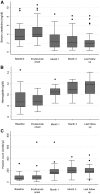Eculizumab in secondary atypical haemolytic uraemic syndrome
- PMID: 28339660
- PMCID: PMC5410989
- DOI: 10.1093/ndt/gfw453
Eculizumab in secondary atypical haemolytic uraemic syndrome
Abstract
Background: Complement dysregulation occurs in thrombotic microangiopathies (TMAs) other than primary atypical haemolytic uraemic syndrome (aHUS). A few of these patients have been reported previously to be successfully treated with eculizumab.
Methods: We identified 29 patients with so-called secondary aHUS who had received eculizumab at 11 Spanish nephrology centres. Primary outcome was TMA resolution, defined by a normalization of platelet count (>150 × 10 9 /L) and haemoglobin, disappearance of all the markers of microangiopathic haemolytic anaemia (MAHA), and improvement of renal function, with a ≥25% reduction of serum creatinine from the onset of eculizumab administration.
Results: Twenty-nine patients with secondary aHUS (15 drug-induced, 8 associated with systemic diseases, 2 with postpartum, 2 with cancer-related, 1 associated with acute humoral rejection and 1 with intestinal lymphangiectasia) were included in this study. The reason to initiate eculizumab treatment was worsening of renal function and persistence of TMA despite treatment of the TMA cause and plasmapheresis. All patients showed severe MAHA and renal function impairment (14 requiring dialysis) prior to eculizumab treatment and 11 presented severe extrarenal manifestations. A rapid resolution of the TMA was observed in 20 patients (68%), 15 of them showing a ≥50% serum creatinine reduction at the last follow-up. Comprehensive genetic and molecular studies in 22 patients identified complement pathogenic variants in only 2 patients. With these two exceptions, eculizumab was discontinued, after a median of 8 weeks of treatment, without the occurrence of aHUS relapses.
Conclusion: Short treatment with eculizumab can result in a rapid improvement of patients with secondary aHUS in whom TMA has persisted and renal function worsened despite treatment of the TMA-inducing condition.
Keywords: atypical haemolytic uraemic syndrome; complement activation; eculizumab; thrombotic microangiopathies.
© The Author 2017. Published by Oxford University Press on behalf of ERA-EDTA.
Figures
Similar articles
-
A systematic review of the role of eculizumab in systemic lupus erythematosus-associated thrombotic microangiopathy.BMC Nephrol. 2020 Jun 30;21(1):245. doi: 10.1186/s12882-020-01888-5. BMC Nephrol. 2020. PMID: 32605540 Free PMC article.
-
Safety and effectiveness of eculizumab for pediatric patients with atypical hemolytic-uremic syndrome in Japan: interim analysis of post-marketing surveillance.Clin Exp Nephrol. 2019 Jan;23(1):112-121. doi: 10.1007/s10157-018-1610-2. Epub 2018 Jul 23. Clin Exp Nephrol. 2019. PMID: 30039480 Free PMC article.
-
Interventions for atypical haemolytic uraemic syndrome.Cochrane Database Syst Rev. 2021 Mar 23;3(3):CD012862. doi: 10.1002/14651858.CD012862.pub2. Cochrane Database Syst Rev. 2021. PMID: 33783815 Free PMC article.
-
Safety and effectiveness of eculizumab for adult patients with atypical hemolytic-uremic syndrome in Japan: interim analysis of post-marketing surveillance.Clin Exp Nephrol. 2019 Jan;23(1):65-75. doi: 10.1007/s10157-018-1609-8. Epub 2018 Jun 29. Clin Exp Nephrol. 2019. PMID: 29959568 Free PMC article.
-
Atypical haemolytic uraemic syndrome treated with the complement inhibitor eculizumab: the experience of the Australian compassionate access cohort.Intern Med J. 2015 Oct;45(10):1054-65. doi: 10.1111/imj.12864. Intern Med J. 2015. PMID: 26247170
Cited by
-
End stage renal disease in patient with microscopic polyangiitis and atypical hemolytic-uremic syndrome arose 3 weeks after the third dose of anti-SARS-CoV2 vaccine mRNA-1273: A case report with literature revision.Medicine (Baltimore). 2023 Dec 15;102(50):e36560. doi: 10.1097/MD.0000000000036560. Medicine (Baltimore). 2023. PMID: 38115241 Free PMC article.
-
Complement Blockade Is a Promising Therapeutic Approach in a Subset of Critically Ill Adult Patients with Complement-Mediated Hemolytic Uremic Syndromes.J Clin Med. 2022 Feb 1;11(3):790. doi: 10.3390/jcm11030790. J Clin Med. 2022. PMID: 35160242 Free PMC article. Review.
-
Use of Eculizumab in Pediatric Patients With Transplant Associated Thrombotic Microangiopathy.Front Pediatr. 2021 Nov 11;9:761726. doi: 10.3389/fped.2021.761726. eCollection 2021. Front Pediatr. 2021. PMID: 34858907 Free PMC article.
-
Atypical Hemolytic Uremic Syndrome Associated with BNT162b2 mRNA COVID-19 Vaccine in a Kidney Transplant Recipient: A Case Report and Literature Review.Infect Dis Rep. 2025 Feb 11;17(1):14. doi: 10.3390/idr17010014. Infect Dis Rep. 2025. PMID: 39997466 Free PMC article.
-
New findings in preventing recurrence and improving renal function in AHUS patients after renal transplantation treated with eculizumab: a systemic review and meta-analyses.Ren Fail. 2023 Dec;45(1):2231264. doi: 10.1080/0886022X.2023.2231264. Ren Fail. 2023. PMID: 37563792 Free PMC article.
References
-
- George JN, Nester CM.. Syndromes of thrombotic microangiopathy. N Engl J Med 2014; 371: 654–666 - PubMed
-
- Noris M, Remuzzi G.. Atypical hemolytic-uremic syndrome. N Engl J Med 2009; 361: 1676–1687 - PubMed
-
- Besbas N, Karpman D, Landau D. et al. A classification of hemolytic uremic syndrome and thrombotic thrombocytopenic purpura and related disorders. Kidney Int 2006; 70: 423–431 - PubMed
-
- Campistol JM, Arias M, Ariceta G. et al. An update for atypical haemolytic uraemic syndrome: diagnosis and treatment. A consensus document. Nefrologia 2015; 35: 421–447 - PubMed
MeSH terms
Substances
LinkOut - more resources
Full Text Sources
Other Literature Sources


